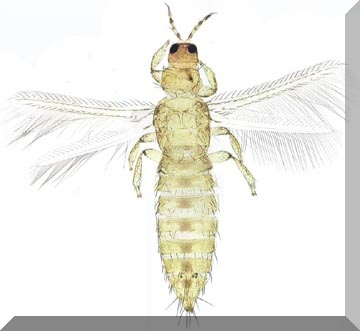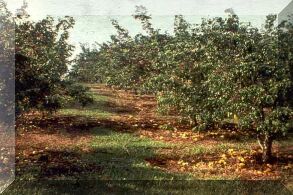Research

Frankliniella occidentalis (Pergande)Thrips (singular and plural form) (order Thysanoptera) are very small and relatively "invisible" insects. Most thrips are saprophytic, however, there are a number of thysanoptera that feed on plant materials and other arthropods. Numerous species are recognized world-wide as agricultural pests, primarily those in the genera Thrips and Frankliniella.
Thrips punch plant cells with their unique mouthparts and suck up the fluids within. This feeding behavior can lead to "silvering" of the leaves and fruit and a significant reduction in photosynthetic potential.
- TSWV (Tospovirus spp.) on tomato
However, the greatest damage inflicted comes from a thrips-vectored disease commonly called tomato spotted wilt virus (TSWV).TSWV can infect over 900 hundred different plant species in 80 botanical families including peanuts, lettuce, peas, potatoes, peppers, tobacco, tomatoes, and many ornamentals, having a high economic impact on agriculture in the around the world.
In 2000, the State of Georgia had losses of over $33 million in peanuts from TSWV damage alone.
Symptoms of TSWV include necrosis, chlorosis and mosaic mottling of most plant tissues. Fruits on innoculated plants are usually necrotic, small and/or deformed. TSWV is generally fatal in younger plants. IPM (integrated pest management) is a systemic approach to pest control. It is developed for a specific agroecosystem and seeks to minimize or eliminate use of pesticides and herbicides by relying heavily on a combination of biological control, cultural practice modification and monitoring.
In addition to reducing the amount of chemical pesticides and herbicides in food or at non-target sites (downstream), use of biocontrol agents usually allows for a a more sustained solution. The natural enemies do most of the work and constantly regenerate their own replacements.
Monitoring and modifying levels of predators and parasites in a system generally keep target organism populations in check.
The "minute pirtate bug" Orius insidiosus (Hemiptera: Anthocoridae) is a predator of many small arthropods, including thrips. These bugs are currently being mass-reared and becoming commonly used as a natural enemies of pest species in organic, IPM and greenhouse arrangements. Previous studies has shown that once predator-prey ratios reach a certain level, pirate bugs are able to rapidly and permanently suppress thrips populations.
- Orius insidiosus (Say)
Our current research is revealing that the native Florida flower thrips (Frankliniella bispinosa) is more vagile and better able to avoid predation by O. insidiosus than the invasive WFT (F. occidentalis). However, both of these species are competent vectors of TSWV.This research will help us to better understand the ecological interactions between O. insidiosus and its thrips prey for application in the current IPM program.
Other aspects of the N. Florida pepper IPM program include use of UV reflective mulches which bombard incoming thrips with ultraviolet light, making those agricultural plots unattractive to them. Another tool in this IPM program is a representative of a new class of biological insecticide, spinosad. Spinosad was derrived from products resulting from fermentation of a bacteria (Saccharopolyspora spinosa (oddly found in a rum vat in Barbados)). This biological pesticide significantly reduces thrips levels, has a low vertebrate toxicity and causes no significant mortality to most thrips predators.

